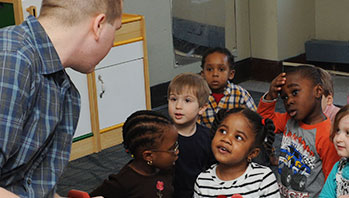- pictures of objects that illustrate “high” (e.g., airplane in sky, cloud, balloon in sky)
- pictures of objects that illustrate “low” (e.g., worm, grass, rug)
- high
- loud
- low
- pitch
- soft
- volume
MA Standards:
Speaking and Listening/SL.PK.MA.1: Participate in collaborative conversations with diverse partners during daily routines and play.
Language/L.PK.MA.1: Demonstrate use of oral language in informal everyday activities.
MA Draft STE Standards:
Physical Sciences/Matter and Its Interactions/PS4.B: Apply their understanding in their play of how to change volume and pitch of some sounds.
Head Start Outcomes:
Language Development/Receptive Language: Attends to language during conversations, songs, stories, or other learning experiences.
Language Development/Expressive Language: Uses language to express ideas and needs.
Logic and Reasoning/Reasoning and Problem Solving: Classifies, compares, and contrasts objects, events, and experiences.
Science Knowledge/Scientific Skills and Method: Uses senses and tools, including technology, to gather information, investigate materials, and observe processes and relationships.
PreK Learning Guidelines:
English Language Arts/Language 2: Participate actively in discussions, listen to the ideas of others, and ask and answer relevant questions
Science and Technology/Living Things and Their Environment 15: Use their senses of sight, hearing, touch, smell, and taste to explore their environment using sensory vocabulary.
Talk Together: High and Low Voices

© Commonwealth of Massachusetts, Department of Early Education and Care (Jennifer Waddell photographer). All rights reserved.
STEM Key Concepts: Sounds have a source; Sounds vary in three ways: volume, pitch, and timbre;
ELA Focus Skills: Speaking and Listening, Vocabulary
Review the concept of volume with children. Then introduce the concept of pitch. Discuss how when you speak loudly or whisper softly, you are changing the volume of your voice.
- Tell children they can also change the pitch of their voice pitch (how high or low their voice is). Ask children to think about the voices of their family members. Ask children if anyone in their family has a low sounding voice. A high sounding voice. Help children understand pitch by demonstrating high and low pitch voices.
- Display the pictures for children to see. Point to the pictures that illustrate “high” and ask, What is the same about all of these pictures? Once children determine that they show things that are up high, repeat with the “low” pictures.
- Then demonstrate a high voice as you point to the high pictures. Repeat with the low pictures. Ask, Is my voice high or low? Point to a picture and ask children to identify it by saying either high or low in a high or low voice as you did. Repeat until everyone has had a turn.
